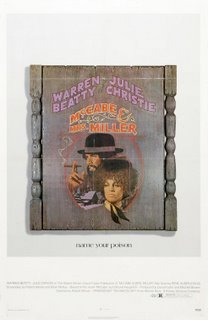"McCabe and Mrs. Miller" at the IFC Center

The hip, lovely IFC Center has been showing several Robert Altman movies throughout January to honor the recently departed director. We jumped at the chance to see Altman’s revisionist Western, “McCabe and Mrs. Miller” (1971), on the big screen, having only ever seen a lousy video from the wonderful Scarecrow in Seattle. And we weren’t disappointed.
Altman’s tale of a gambling man and his business partner, a madam and part-time prostitute, little resembles the typical Western, in which a brave white man rides into a desert town behind a setting sun. As the movie begins, McCabe (Warren Beatty) rides through the pouring rain into a half-finished town named Presbyterian Church in the Pacific Northwest, establishing the movie’s bleak, wet tone. It’s clear that any hold civilization gains over nature here will be tenuous, at best.
McCabe eventually hooks up with Mrs. Miller (Julie Christie), a hooker who doesn’t have a heart of gold. Instead, she has an addiction to opium and a savvy business sense. (McCabe’s inability with numbers is a running joke.) They make a tidy profit together and begin to fall in love, though Mrs. Miller continues to charge McCabe for sex. After McCabe unwisely rejects a local mining outfit’s offer to buy him out, Mrs. Miller begins to fear for McCabe’s life. She knows that the corporate monopoly won’t make another offer.
Aside from the heavy-handed soundtrack by Leonard Cohen, “McCabe and Mrs. Miller” makes no mistakes as it indicts big business and re-thinks the stories we tell ourselves about manifest destiny. It uses Altman’s trademark overlapping sounds, as well as a perfect color palette of soft browns and yellows for the interior scenes and of whites and blues for the noteworthy outdoor scenes. And the final shot of Mrs. Miller is one of Hollywood’s most haunting conclusions.
Comments
Post a Comment